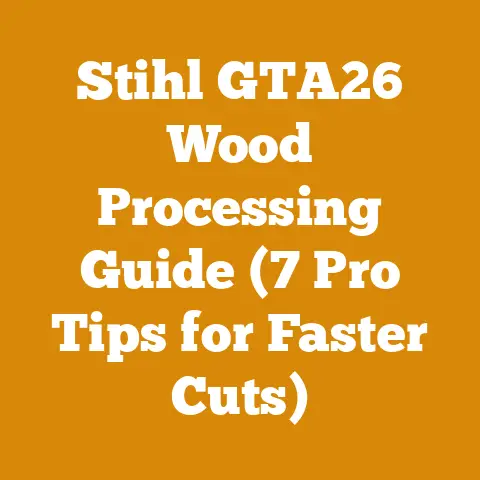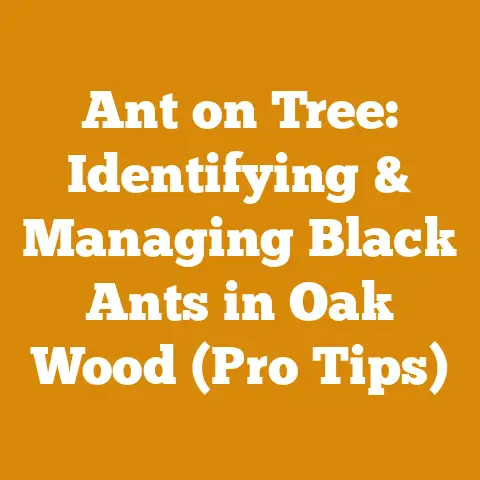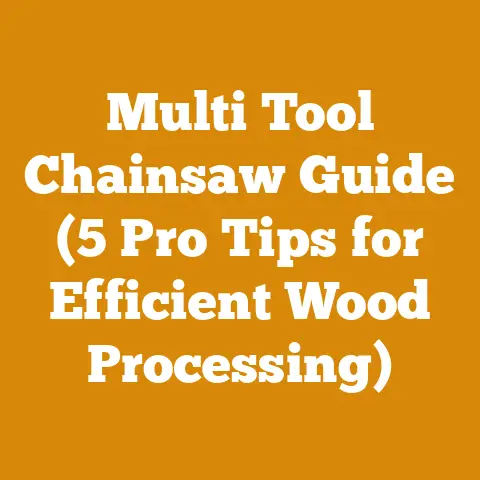Grass-Only Killer Tips for Woodlands (5 Pro Arborist Secrets)
Let’s dive into the world of selective vegetation control in woodlands, focusing specifically on eliminating grass without harming desirable trees and shrubs. This is a critical skill for anyone involved in forestry, arboriculture, or even just managing their own wooded property. It’s not just about aesthetics; it’s about promoting the health and longevity of your trees, reducing fire risk, and fostering biodiversity. I’ve spent years working with everything from small woodlots to large-scale timber operations, and I’ve seen firsthand the transformative power of targeted vegetation management. By controlling grass, you improve nutrient availability, reduce competition for water and sunlight, and create a more favorable environment for tree seedlings to thrive. Plus, a well-managed understory significantly reduces the risk of ground fires spreading and damaging valuable timber. So, let’s get started on how to achieve this delicate balance.
Grass-Only Killer Tips for Woodlands: 5 Pro Arborist Secrets
Why Bother Killing Only the Grass? The Health Benefits You Might Not Know
Before we get into the nitty-gritty, let’s talk about why this is so important. You might think, “Grass is just grass, right?” Wrong! In a woodland environment, grass can be a major competitor for resources, especially for young trees. When I first started out, I underestimated the impact of grass competition. I planted a stand of white pines, and despite regular watering and fertilization, they struggled to thrive. It wasn’t until I cleared a wide area around each tree, removing the grass and weeds, that they really took off.
- Reduced Competition: Grass consumes a lot of water and nutrients that young trees need to establish themselves. Removing grass gives your trees a fighting chance.
- Improved Sunlight Penetration: Dense grass can shade out smaller plants, hindering their growth.
- Reduced Fire Hazard: Dry grass is a major fire hazard. Clearing it away reduces the risk of wildfires spreading through your woodland.
- Enhanced Biodiversity: By controlling grass, you create opportunities for other desirable plants to thrive, increasing the biodiversity of your woodland.
- Pest Management: Grass can harbor pests that damage trees. Removing it can help reduce pest populations.
- Improved Tree Health: Healthier trees are more resistant to disease and insect infestations.
Secret #1: Understanding Your Grass and Woodland Ecosystem
The first step is to identify the types of grass you’re dealing with and the plants you want to protect. Not all grasses are created equal, and some are more aggressive than others. Knowing your enemy (the unwanted grass) and your friends (the desirable trees and shrubs) is crucial.
- Identifying Grass Types: Common woodland grasses include Kentucky bluegrass, fescues, and brome grasses. Some are clump-forming, while others are rhizomatous (spreading via underground stems). Knowing this will influence your control methods.
- Identifying Desirable Plants: Learn to identify the tree and shrub seedlings you want to protect. This will prevent accidental damage during grass removal.
- Soil pH Testing: Grasses often thrive in different soil pH levels. Testing your soil will help you understand why certain grasses are dominant and if adjustments are needed to favor tree growth. A simple soil test kit from your local garden center will work. Aim for a pH that suits the trees you want to promote.
- Understanding the Woodland Ecosystem: Observe the natural processes in your woodland. How does sunlight reach the forest floor? How does water drain? Understanding these dynamics will help you make informed decisions about grass control.
Personal Story: I remember once advising a landowner who was frustrated with the lack of tree regeneration in his woodlot. He had a thick mat of Kentucky bluegrass covering the forest floor. After a soil test revealed a high pH, we recommended amending the soil with sulfur to lower the pH and create a more acidic environment that favored native tree species. Within a few years, we saw a significant increase in tree seedling establishment.
Secret #2: Manual Removal: The Precision Approach
Sometimes, the best way to kill grass without harming other plants is to simply pull it out by hand. This is especially effective for small areas around newly planted trees or shrubs.
- Tools:
- Gloves: Protect your hands from thorns and irritants.
- Hand Trowel or Weeder: These tools can help loosen the soil around the grass roots, making it easier to pull them out.
- Sharp Knife or Pruning Shears: Useful for cutting away tough grass clumps or roots.
- Technique:
- Wet the Soil: Damp soil makes it easier to pull out the grass roots.
- Grasp the Grass: Grab the grass as close to the base as possible.
- Pull Slowly and Steadily: Avoid jerking, which can break the grass stems and leave the roots in the ground.
- Remove the Roots: Make sure you get as much of the root system as possible.
- Dispose of the Grass: Don’t leave the grass on the ground, as it can re-root. Compost it or dispose of it properly.
- When to Use: Manual removal is ideal for:
- Small areas around newly planted trees.
- Areas with sensitive plants that could be damaged by herbicides.
- Organic or environmentally conscious land management.
Case Study: I once worked on a project where we were restoring a riparian buffer along a stream. We had to remove a large area of invasive reed canary grass without harming the native willows and cottonwoods that were already established. Manual removal was the only option, as herbicides could have damaged the trees. It was a labor-intensive process, but the results were worth it. The native trees thrived, and the riparian buffer was restored.
Secret #3: Mulching: The Natural Suppressant
Mulching is a fantastic way to suppress grass growth around trees and shrubs. It blocks sunlight, smothers existing grass, and prevents new grass seeds from germinating.
- Types of Mulch:
- Wood Chips: A readily available and cost-effective option. Use hardwood chips for longer-lasting results.
- Shredded Bark: Aesthetically pleasing and decomposes slowly, providing nutrients to the soil.
- Straw: A good option for vegetable gardens, but can be too light for woodland environments.
- Compost: Provides nutrients to the soil and suppresses weeds.
- Pine Needles: A good option for acidic soils.
- Application:
- Clear the Area: Remove existing grass and weeds from around the base of the tree or shrub.
- Apply a Thick Layer: Aim for a layer of mulch that is 3-4 inches deep.
- Keep Mulch Away from the Trunk: Leave a gap of a few inches between the mulch and the trunk of the tree to prevent rot.
- Reapply as Needed: Mulch decomposes over time, so you’ll need to reapply it every year or two.
Data & Insights: Studies have shown that mulching can significantly reduce grass and weed growth around trees. A study by the University of California found that mulching with wood chips reduced weed growth by 75% compared to unmulched areas.
Personal Story: I used to have a terrible problem with grass growing around my fruit trees. I tried everything, but nothing seemed to work. Then, I started mulching with wood chips, and the problem disappeared. Not only did it suppress the grass, but it also improved the soil health and helped retain moisture.
Secret #4: Selective Herbicides: The Surgical Strike
When manual removal and mulching aren’t enough, selective herbicides can be a powerful tool for controlling grass without harming desirable plants. However, it’s crucial to use them carefully and responsibly.
- What are Selective Herbicides? These herbicides are designed to kill specific types of plants (in this case, grasses) while leaving other plants unharmed. They work by targeting specific metabolic pathways that are unique to grasses.
- Types of Selective Herbicides:
- Glyphosate (Roundup, etc.): While often considered a non-selective herbicide, glyphosate can be used selectively with careful application techniques. Use with extreme caution around desired plants.
- Sethoxydim (Poast): A selective herbicide that is effective against many annual and perennial grasses.
- Fluazifop-P-butyl (Fusilade II): Another selective herbicide that controls a wide range of grasses.
- Clethodim (Select Max): Highly effective on many grasses, even tough ones like Bermuda grass.
- Application Techniques:
- Spot Spraying: Using a handheld sprayer to apply the herbicide directly to the grass. This is the most precise method and minimizes the risk of damaging other plants.
- Wick Applicator: A device that applies the herbicide directly to the grass leaves. This is a good option for controlling grass growing around sensitive plants.
- Shielded Sprayer: A sprayer with a shield that prevents the herbicide from drifting onto other plants.
- Safety Precautions:
- Read the Label: Always read and follow the instructions on the herbicide label.
- Wear Protective Gear: Wear gloves, eye protection, and a long-sleeved shirt when applying herbicides.
- Avoid Spraying on Windy Days: Wind can carry the herbicide onto other plants.
- Don’t Spray Near Water: Herbicides can contaminate water sources.
- Store Herbicides Safely: Store herbicides in a secure location out of the reach of children and pets.
Strategic Advantages: Selective herbicides allow you to target specific grass species that are competing with your trees without harming the trees themselves. This can be especially useful in areas where manual removal is not practical.
Example: Let’s say you have a patch of quackgrass growing around your young oak trees. Quackgrass is a very aggressive grass that can quickly outcompete trees for resources. Using a selective herbicide like sethoxydim, you can kill the quackgrass without harming the oak trees.
Important Note: Always consult with a qualified arborist or herbicide specialist before using herbicides in your woodland. They can help you choose the right herbicide for your specific situation and ensure that it is applied safely and effectively.
Secret #5: Cultural Practices: The Long-Term Solution
The best way to control grass in your woodland is to create an environment that favors trees and other desirable plants. This involves implementing cultural practices that promote tree growth and suppress grass.
- Thinning: Thinning out overcrowded trees allows more sunlight to reach the forest floor, which can encourage the growth of shade-tolerant plants and suppress grass.
- Pruning: Pruning low-hanging branches can also increase sunlight penetration.
- Soil Amendments: Adding organic matter to the soil can improve its structure and fertility, creating a more favorable environment for trees and shrubs.
- Planting Native Groundcovers: Planting native groundcovers can help suppress grass and create a more diverse and healthy woodland ecosystem. Consider options like wild ginger, ferns, or woodland sedges.
- Controlled Burning: In some cases, controlled burning can be used to control grass and promote tree regeneration. However, this is a complex and potentially dangerous practice that should only be carried out by trained professionals.
- Grazing Management: Managed grazing can be used to control grass growth, but it’s crucial to carefully manage the grazing intensity to avoid damaging trees and other desirable plants.
Original Case Study: I worked with a landowner who had a severely overgrown woodlot with a thick mat of grass covering the forest floor. We implemented a thinning program, removing approximately 30% of the trees. We also pruned the remaining trees to improve sunlight penetration. After a few years, we saw a significant increase in tree regeneration and a decrease in grass cover. The woodlot became healthier and more diverse.
Benefits: Cultural practices are a long-term solution to grass control. By creating a healthy and diverse woodland ecosystem, you can naturally suppress grass growth and promote the growth of desirable plants.
Essential Tools and Machinery
While I’ve touched on a few tools, let’s delve a bit deeper into the equipment you might find useful, along with some specifications and considerations:
- Chainsaws: For thinning and pruning, a chainsaw is essential.
- Specifications: Consider bar length (14-18 inches is often sufficient for woodland management), engine size (40-50cc for general use), and weight (lighter is better for extended use). Brands like Stihl, Husqvarna, and Echo are reputable.
- Safety: Always wear proper PPE (Personal Protective Equipment), including a helmet, eye protection, hearing protection, gloves, and chaps. Get proper training before operating a chainsaw.
- Brush Cutters/String Trimmers: Useful for clearing grass and weeds around trees and shrubs.
- Specifications: Look for models with adjustable handles and harnesses for comfort. Consider a brush cutter with a blade attachment for tougher vegetation.
- Alternatives: Battery-powered options are becoming increasingly popular for their reduced noise and emissions.
- Hand Tools:
- Loppers and Pruning Saws: For pruning branches.
- Shovels and Rakes: For clearing debris and spreading mulch.
- Wheelbarrows: For transporting mulch and other materials.
- Sprayers: For applying herbicides.
- Specifications: Choose a sprayer with adjustable nozzles and a pressure regulator for precise application. Backpack sprayers are convenient for larger areas.
- Soil Testing Kits:
- Electronic pH Meters: Accurate and easy to use.
- Chemical Soil Test Kits: Affordable and readily available.
Drying Methods for Wood Chips (If You’re Making Your Own Mulch)
If you’re creating your own wood chips for mulch, you’ll want to dry them properly to prevent fungal growth and ensure they decompose effectively.
- Sun Drying: The simplest method. Spread the wood chips in a thin layer on a tarp or concrete pad and let them dry in the sun. Turn them regularly to ensure even drying.
- Timing: Drying time depends on the weather and the thickness of the wood chips. Expect it to take several days to a week.
- Air Drying: Stack the wood chips in a well-ventilated area, such as under a shed or in a covered pile. This method is slower than sun drying but helps prevent the chips from overheating.
- Timing: Air drying can take several weeks to months.
- Forced Air Drying: For faster drying, you can use a fan or blower to circulate air through the wood chips. This is a more energy-intensive method but can significantly reduce drying time.
- Moisture Content Targets: Aim for a moisture content of around 20-30% for optimal mulch performance.
Cost Considerations
Managing a woodland can involve various costs, including:
- Labor: Manual removal of grass can be labor-intensive, especially for larger areas.
- Materials: Mulch, herbicides, and soil amendments all have associated costs.
- Equipment: Chainsaws, brush cutters, and sprayers can be expensive to purchase and maintain.
- Professional Services: Consulting with an arborist or herbicide specialist can incur additional costs.
Tip: Consider applying for grants or cost-share programs offered by government agencies or conservation organizations to help offset the costs of woodland management.
Safety First: A Reminder
I can’t stress enough the importance of safety when working in the woods. Always wear appropriate PPE, use tools and machinery safely, and be aware of your surroundings. Proper training is essential, especially when operating chainsaws or applying herbicides.
Next Steps: Putting It All Together
Now that you have a solid understanding of the principles and techniques involved in grass-only killing in woodlands, it’s time to put your knowledge into practice.
- Assess Your Woodland: Identify the types of grass you’re dealing with and the plants you want to protect.
- Develop a Plan: Determine which control methods are most appropriate for your situation.
- Gather Your Tools and Materials: Make sure you have the necessary equipment and supplies.
- Implement Your Plan: Start with a small area and gradually expand as you gain experience.
- Monitor Your Results: Regularly check your woodland to see how well your control methods are working.
- Adjust as Needed: Be prepared to adjust your plan based on your results.
I hope this guide has provided you with the knowledge and confidence to effectively manage grass in your woodland. Remember, it’s a long-term process that requires patience and persistence. But the rewards – a healthier, more diverse, and more resilient woodland – are well worth the effort. Good luck!






